
When it comes to auto racing, there is an old adage that states, “In the constant pursuit of a quicker elapsed time (ET), a faster mph, or a consistent part, evaluating never ends.” After a recent Hughes Engines’ test in Mopar Connection Magazine comparing single- vs. dual-plane manifolds, we wanted to perform a “real-world” drag strip test. With a single-plane currently installed, we needed a dual-plane for our 340 equipped Dart, so we acquired an Edelbrock Performer RPM Air-Gap intake manifold (PT# EDL-7576) from Hughes Engines. Based on the Hughes Engines’ test, the Air-Gap should increase mid-range horsepower helping to propel the Dart down the quarter mile a few hundreds of a second quicker than our current Edelbrock Torker II manifold. But would it?
The Dart has a .040-inch over 340 with a ’68 stock forged steel crankshaft swinging Scat H-beam rods with Speed Pro pistons and pins. The camshaft is a 30-year-old solid-lifter DC Purple Shaft with .557-inch lift and 296° of duration. Edelbrock aluminum cylinder heads top the block and 1.5:1 roller rockers actuate the valves. A gasket-matched Edelbrock Torker II manifold rests on the heads and a tapered four-hole, one-inch spacer (best spacer tested with this combination) coupled with a Holley 830 carburetor sits atop the manifold.
Above Left: Edelbrock’s Torker II (PT# EDL-5076) intake manifold features a single-plane, low-rise design that provides high rpm horsepower without affecting the mid-range power. Above Right: Edelbrock’s Performer RPM Air-Gap (part no. EDL-7576) is a dual-plane 180-degree design. The RPM Air-Gap has an open-air space between the runners and the lifter valley, which reduces the amount of heat transferred from the engine into the manifold.
Above Left: This cross section of the Torker II shows the manifold’s internal design, which is designed with minimal turns of the intake runners. The Torker II is constructed for applications with limited hood clearance. This manifold is designed to make power from 2,500 to 6,500 rpm. Above Right: This cross section shows the upper and lower runner design. This manifold is based upon the successful RPM-series but includes a unique air gap for a cooler denser mixture for more power. A great disadvantage of a dual-plane intake can be the meandering runner design and the direction changes the air-fuel charge must make to reach the intake valves. The RPM Air-Gap is designed to make power from 1,500 to 6,500 rpm.
The engine breathes through a 14 x 5-inch K&N air filter, and the spent gasses exit via a pair of Hooker Competition headers with 1 5/8-inch primaries flowing into 3-inch collectors with 6-inch extensions. A foot-braked reverse-manual Torqueflite 904 attaches to the 340, and a PTC 9.5-inch torque converter with a flash stall speed of 5200 rpm passes the torque to the transmission. A Denny’s driveshaft transfers the torque to a 4.10 geared 8 ¾-inch rear end, which rides on mono-leaf springs with Cal-Trac bars. With the Torker II and the spacer, the Dart runs consistent 60-foot times in the 1.52-1.54 second range with quarter mile ETs in the 11.40s at 115 mph. The best run with this combination is an 11.358 ET at 117.17 mph with a 1.500 second 60-foot time (at Numidia Dragway).
The Torker II features a low-rise, single-plane casting designed to maximize the high rpm horsepower. The intake distributes the air-fuel charge with a nearly straight shot from the carburetor to the intake valves. This manifold is intended to make power from 2,500-6,500 rpm. The RPM Air-Gap is a dual-plane casting designed to provide excellent mid-range torque and throttle response. With its 180° manifold design, a primary and secondary barrel of the carburetor feed four of the eight cylinders (1-4-6-7 or 8-3-5-2), which provides a stable idle. The Air-Gap operates in the 1,500-6,500-rpm range. A disadvantage of a dual-plane intake is the meandering runner design the air-fuel charge follows to reach the intake valves.

Above: The 340 is fed via an annular discharge 830 cfm Holley four barrel. The carburetor has been optimized for the current combination with 84 jets in the primaries and 86 jets in the secondaries. A pair of 50-cc accelerator pumps push fuel to a .035-inch primary and a .035-inch secondary discharge nozzle.
Above Left: The current engine combination has an Edelbrock Torker II manifold with a tapered four-hole, one-inch carb spacer. The manifold has been on the engine for over a decade, and our 1969 Dart’s performance has been excellent with consistent 60-foot times in the 1.52-1.54 second range with mid-to-high 11.40s in the quarter mile at about 115 mph. Above Right: With our current engine combination, the fiberglass lift-off Six Pack hood provides plenty of hood clearance for either manifold. A Holley 830 cfm carburetor sits under the 14 x 5-inch K&N air filter. The air filter is comfortably positioned in the inlet air of the hood scoop.
To establish a baseline, we towed the Dart to Beaver Springs Dragway for a test-and-tune day. Once unloaded at the track, the Dart passed through tech, and the 340 and drivetrain was warmed up. The fuel cell was topped off with 93-octane pump gasoline, the tire air pressures were adjusted (15 psi for the slicks and 45 psi for the skinnies up front), and the weather station was set up before the Dart was driven to the scales. The Dart weighed 2874lbs, and the driver added another 200lbs.
After weigh in we hit the staging lanes. Once we made it to the start line, we did a quick burnout to heat up the 26 x 9-inch Hoosier slicks, the Dart rolled forward stopping when the pre-stage beam was broken. The 340 revved to 3500 rpm, and the Dart was carefully bumped into the stage beam. The lights dropped down the Christmas tree, and with the flicker of the last amber, the Dart was off. A yank of the B&M shifter handle at every flash of the shift light (6200 rpm) stirred the Torqueflite through the gears and across the finish line.
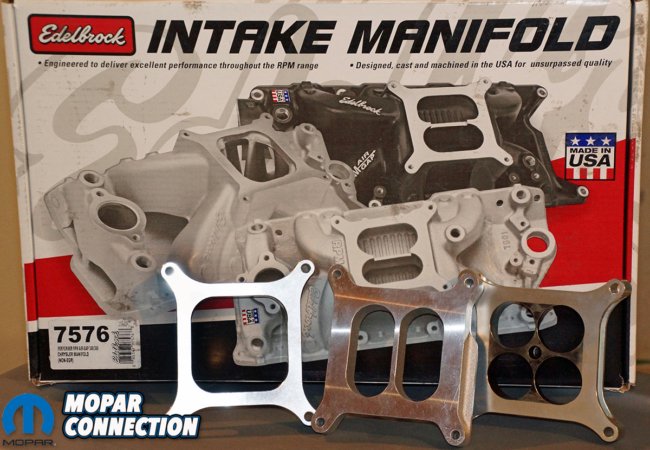
Above: We tested multiple spacers with the Edelbrock RPM Air-Gap and all of them netted different results.
Above Left: The Torker II manifold was removed, and the Performer RPM Air-Gap manifold was slipped into its place on top of a new Fel-Pro gasket set. The intake manifold bolts were torqued to spec. In this picture, we had already reconnected the thermostat housing, installed a new by-pass hose, and filled the cooling system. Above Right: The tapered four-hole, one-inch carb spacer was the first spacer we tested at the strip. We had extensively tested the spacer and found it to be the best spacer with the Torker II, so we reinstalled it on the Air-Gap manifold for our first series of tests with the RPM Air-Gap.
The result of the Torker II with the tapered four-hole spacer was a best ET of 11.374 at 114.94 mph with a 60-foot time of 1.503 seconds. Three additional runs netted an ET range of 11.374 to 11.391 seconds. The horsepower correction factor (HPC) of the best run was 1.019, which provided a corrected ET of 11.30 at 115.68 mph. Based upon the finish line trap speed of the best HPC run, the 340 churned out a respectable 334.03 rear wheel horsepower (rwhp).
Back at the shop, we removed the carburetor, drained the cooling system, removed the by-pass hose, and unthreaded the thermostat housing. The manifold bolts were removed, and the manifold was pulled and set aside. The remnants of the intake gaskets were scraped from each cylinder head. New Fel-Pro intake gaskets were laid into place along with the cork end seals. A dab of RTV was applied were the cork end seals met the intake manifold gaskets.
Above Left: Off the trailer, the Dart performed well. The first run was a little lazy, but after a primary discharge nozzle change to a .037-inch nozzle and moving the rev limiter to 6800 rpm, the 340 laid down several impressive runs. The best run was an 11.359 ET at 116.38 mph (7.146 seconds at 93.140 mph in the 1/8th mile) with a 1.535 60-foot time. All the post tuning runs resulted in elapsed times that were better than the baseline. With a 1.02 HPC, the corrected run was an 11.28 ET at 117.15 mph, with a rwhp of 347.04. That is an increase of 13.01 rwhp over the Torker II. (Todd Dziadosz photo) Above Right: The big K&N air filter and housing was placed on the carburetor’s airhorn. The engine oil was changed, and the engine was warmed up to see if coolant, oil, or fuel leaks were present. We had none, so we continued with the routine between race maintenance of the Dart.
Above Left: Pleased with the performance of the Air-Gap and the tapered four-hole, one-inch carb spacer, we pulled the carburetor, removed the four-hole spacer, and replaced it with an open plenum, one-inch spacer. Above Right: We placed the Holley carburetor onto the manifold. The carburetor mounting stud nuts were torqued, and the return springs, fuel lines, and throttle linkage were reattached to the carburetor. The throttle cable was checked for full throttle plate opening at wide-open throttle.
The gasket-matched (by us) RPM Air-Gap from Hughes Engines was placed onto the gaskets, and the manifold fasteners were torqued to spec. The thermostat housing was reinstalled, a new by-pass hose was slipped onto the manifold and the cooling system was refilled. The carburetor was placed onto the Air-Gap manifold along with the tapered four-hole spacer. We adjusted the carburetor for wide-open throttle and reconnected the shifter linkage. The oil was drained, and seven quarts of 5w-30 was poured into the crankcase. With the engine buttoned up, the engine was started and warmed up. No leaks (fuel, coolant, or oil) were noted, so we completed the routine maintenance and readied the Dart for the next test session.
For our Air-Gap test session, the weather was nearly identical to the moderate, cool temperature of the previous week’s test session. The same pre-run procedures were performed, and the Dart’s weight had dropped one pound (the author lost weight). The first run with the Air-Gap resulted in an 11.408 ET at 115.45 mph with a lazy 60-foot of 1.542 seconds. Surprisingly, the 340 hit the 6600-rpm rev limiter in the finish line speed traps.
Above Left: An open plenum spacer is an extension of the neck of the intake manifold. It increases the total area of the intake manifold, which helps with mid-range and high rpm horsepower, and it increases the distance between the bottom of the carburetor and the roof of the intake manifold runners. The spacer helps reduce the air charge from bouncing off the manifold’s floor and disrupting the airflow. Above Right: When testing the open plenum spacer on the Torker II, it finished in second place behind the tapered four-hole spacer. We put the carburetor back on the manifold, adjusted the carburetor for wide-open throttle, and ensured there were no fuel leaks. We dropped the air cleaner on the carburetor and hustled up to the staging lanes for more runs.
Above Left: When we used the tapered four-hole spacer or the open plenum spacer, we negated the benefits of one primary and one secondary from the carburetor feeding four of the eight cylinders with 180-degrees between the intake valves opening. With a divided plenum one-inch spacer, we reestablished the intended design of the Air-Gap manifold. Above Right: The divided plenum spacer required two divided plenum spacer gaskets to ensure there was no leaking between the plenums. This design treats an eight-cylinder engine as if it was two four-cylinder engines. Each “four cylinder” receives induction pulses in evenly spaced intervals. The divided plenum spacer enhances low-speed torque.
An adjustment of the Holley’s primary accelerator discharge nozzle from a .035-inch to a .037-inch and a click of the rev limiter to 6800 rpm had the Dart ready for the next pass. The run resulted in an 11.359 ET at 116.38 mph, and the 60-foot had dropped to 1.535 seconds. Three additional runs with the four-hole spacer resulted in ETs ranging from 11.359 to 11.373 seconds. All the Air-Gap runs (after tuning) with the tapered four-hole, one-inch spacer were better than the baseline best with the Torker II. The HPC of the best run was 1.020, which resulted in a corrected 11.28 ET at 117.15 mph. Based upon the HPC trap speed, the 340 made 347.04 rwhp.
For the next test, we replaced the tapered spacer with a one-inch open plenum spacer. With the rev limiter still set to 6800 rpm, the Dart was put through the paces of another series of passes. The first of the four runs was the best with an 11.285 ET at 116.21 mph with a 60-foot of 1.532 seconds. All of the runs with the open plenum ranged between 11.285 to 11.299 seconds. The combination was deadly consistent, and the 60-foot times were all 1.53 seconds accompanied by small wheelies on each run. The HPC of the best run was 1.027, which delivered a corrected 11.19 ET at 117.25 mph. The HPC mph computed to 347.93 rwhp.

Above: On the track, the divided plenum spacer was a dog. Its performance benefit is well below the rpm the 340 spins on the track. The Dart ran a lackluster 11.539 ET at 115.06 mph, with a lazy 1.570 60-foot time. The 1/8th mile ET was 7.268 seconds at 93.410 mph. At an HPC of 1.040, the 340 managed only 328.80 rwhp, which was 5.23 rwhp less than the baseline. (Todd Dziadosz photo)
The last one-inch spacer to test was the divided plenum spacer. This spacer did not work well with the 340. The 60-foot times were in the 1.57-1.59 second range, and down track, the 340 seemed lethargic. We tried additional jetting and advancing and retarding the ignition timing, but the elapsed times were disappointing when compared to the ETs of the other spacers on the Air-Gap manifold. After all the changes, the best run resulted in an ET of 11.539 at 115.06 mph. The HPC for the best run was up to 1.040, which worked out to be a corrected ET of 11.38 at 116.57 mph.
The 340 seemed the happiest with the RPM Air-Gap and the one-inch open plenum spacer. Based on rwhp, the testing showed the dual-plane Performer RPM Air-Gap manifold as a persuading alternative to the single-plane Torker II manifold. The conventional belief was a single-plane would suffer on the low-end of the power band but would show great gains in the upper-rpm range. With the tapered four-hole carb spacer to help gain some low-end torque, the Torker II provided the best 60-foot times, but trap speeds of only 115 mph.
Meanwhile, the Air-Gap in conjunction with the tapered four-hole spacer, which should have shown better lower-rpm performance, did well off the line with slightly slower 60-foot times, but the trap speeds greatly outpaced the single-plane manifold. Our testing seemed opposite to the well-accepted theories about single- or dual-plane manifolds. While results may differ from engine to engine, our findings confirmed the Hughes Engines’ dyno testing results. Is it time for you to evaluate and modify your street or race combination? For assistance selecting the correct manifold for your engine, give the Hughes Engines reps a call. See you at the strip.



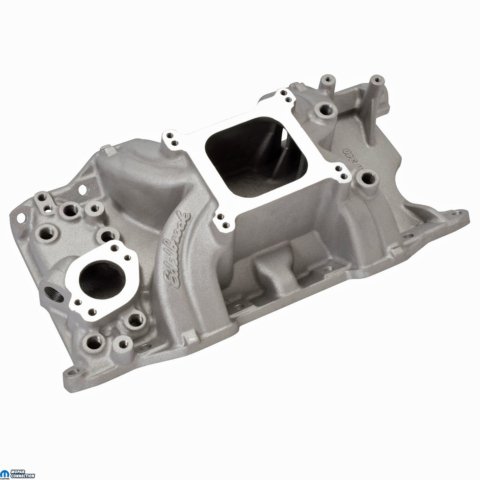
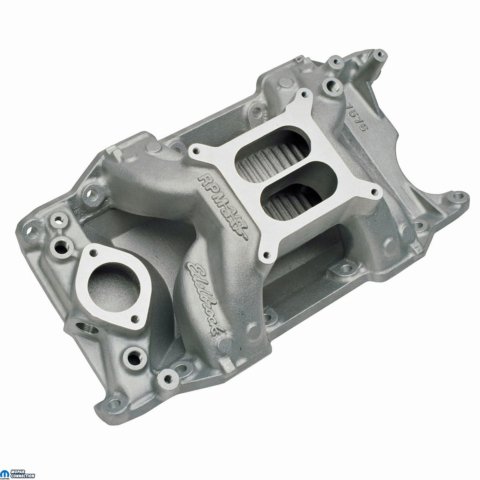



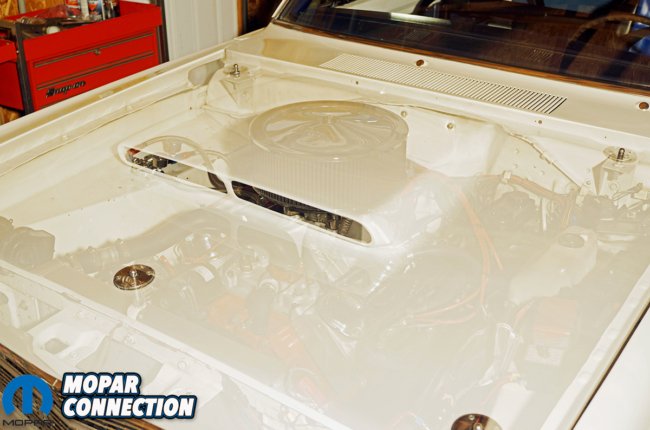

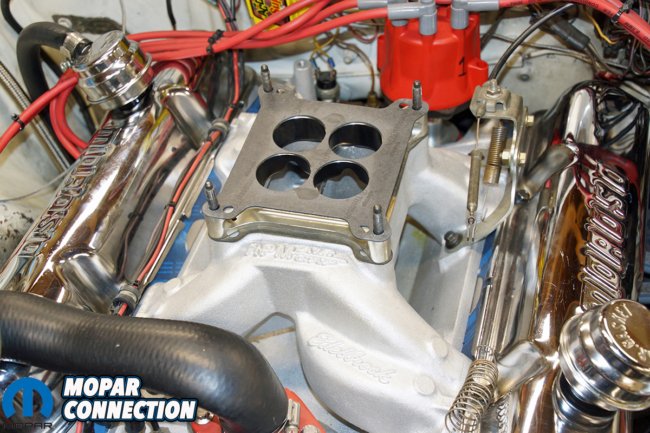

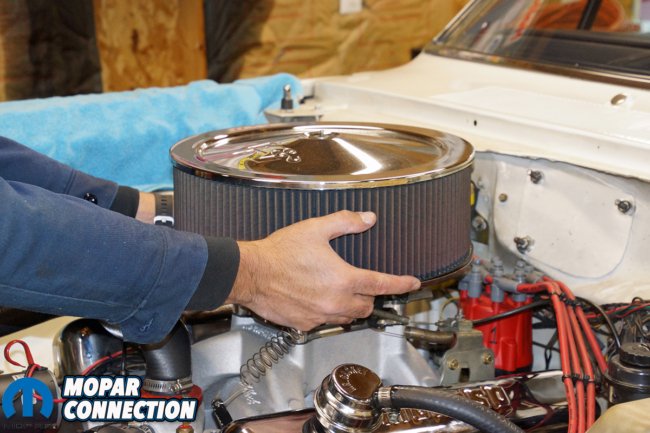
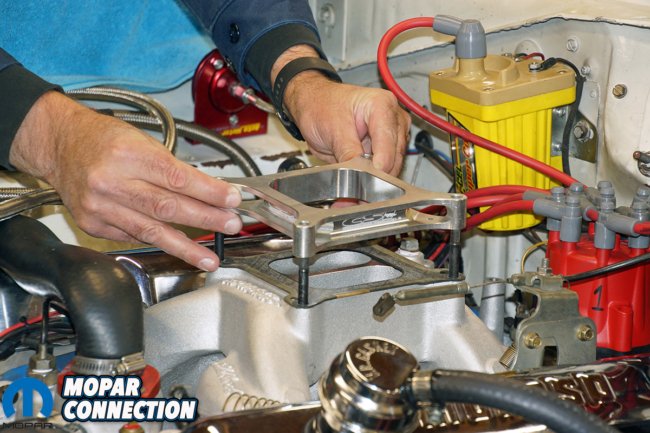





































I have been searching for Holley square bore (1 3/4″) divided plenum carb base gaskets like the one in your article, but it seems nobody carries them. Edelbrock carries a wood composite 1/2″ spacer with gasket but short of that, the gaskets alone can’t be found. Any help? Thanks!